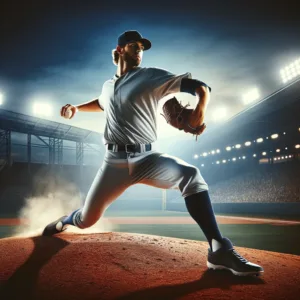 Good afternoon, Brent Pourciau here with Top Velocity.net. Today, I want to address a common issue most low velocity pitchers possess. Which is, they struggle to stabilize and extend the front leg during the pitching delivery. For brevity's sake, we will move past the critical components leading up to front foot strike. If you are interested in learning more about those components, I recommend going through my youtube channel or browsing through the numerous articles I have on this website.
Good afternoon, Brent Pourciau here with Top Velocity.net. Today, I want to address a common issue most low velocity pitchers possess. Which is, they struggle to stabilize and extend the front leg during the pitching delivery. For brevity's sake, we will move past the critical components leading up to front foot strike. If you are interested in learning more about those components, I recommend going through my youtube channel or browsing through the numerous articles I have on this website.
Often times the front side is over coached. However, this can lead to some very accurate throws that lack any power to be effective and be at a higher risk for arm injury. Especially given the evidence that pitchers are now throwing at the highest velocities ever recorded. So, on that note it is important to focus on developing stride power before becoming enamored with the mechanics of the front foot strike. With that out of the way, I would like to say. This article is for those who believe (or know) they have sufficiently powered their stride phase and are looking to maximize their performance! Let's dive into the details. Shall we?
The Science Behind a Strong Front Side
At the moment of front foot strike, a pitcher is at a pivotal juncture where linear momentum meets rotational force, creating a whirlwind of energy that must be harnessed and directed. This is where the concept of a stronger front side comes into play. It serves as a fulcrum, a point of leverage where all this energy can be catapulted towards the target with precision and speed. But achieving this level of control and power is no small feat. It requires a foundation of stability built from the ground up, starting with the ankle and ascending through the knee, hip, and torso, culminating in a coordinated effort that channels energy through the glove side shoulder and elbow.
While my focus will primarily be on ensuring players develop their stride phase, the front leg is the most important factor when it comes to precision. Pitchers can have the most powerful stride phase possible but if they have a front side that cannot handle the demands placed on it. Then the body's ability to generate torque through front leg extension is greatly impaired! Stay with me here. If you truly want to maximize your pitching velocity, you cannot just throw endless pitches. You need to be in an off-season program that will help you build your total body strength so that you can generate and handle more ground forces and then channel that into your pitch. Not only will this increase your pitching velocity, but it will drastically reduce your chance for injury in-season. Now, let's move on to our next section which will dive into this in more detail.
The Role of Physical Conditioning
A common challenge faced by pitchers struggling with front side strength is an inadequate rate of force development. This deficiency predominantly stems from a lack of strength, it has been shown that the force with which the front leg lands is equivalent to 175% of the pitchers' bodyweight (1). A pitcher's ability to stabilize this amount of force at front foot strike is critical because if a pitcher cannot stabilize 175% of his body weight on the front leg, then his body will not allow the drive leg to generate this kind of force through the stride phase. Addressing this issue goes beyond the mound; it extends into the weight room, where strength and power development become paramount. Furthermore, flexibility and mobility across the joints play a crucial role in extending the range within which force can be generated and applied effectively. Power and strength are not going to just appear out of thin air by just doing drills. You need to start pushing yourself on leg day and build up your Olympic lifts so that your body learns to both produce and handle high amounts of force production. The implications of the previously sited study can not be overlooked. The study shows that high-velocity pitchers have tremendous amounts of leg strength, core strength, and power. For the low-velocity pitchers it can only mean one thing. You need to take your off-season seriously and get into a program that will help make you bigger stronger and faster! There is no purpose in wearing yourself out in travel ball and tournaments if you are not performing at an elite level to make the scouts stand up and take notice.
Biomechanics and Sequencing: The Heart of Effective Pitching Velocity
Don't begin to think for a moment that I am contradicting myself here. Yes, strength and conditioning are of extreme importance in developing a stronger pitching delivery, and while I believe it is imperative you build up your body's force production through heavy olympic lifting. Overload and underload training of the pitching delivery is another method that will help hone your mechanics while giving your body the chance to recovery. What I am not an advocate of is, the ridiculously high throw counts that players go through thinking their delivery will improve if they just keep throwing with the same poor mechanics. Beyond physical conditioning, the biomechanical orchestration of the body's movements is pivotal. This is the entire purpose of the 3X med ball drills, to teach the proper mechanics of each phase of the pitching delivery. Proper sequencing—hip rotation followed by shoulder action—is essential for creating and transferring energy efficiently. This coordination ensures a stable platform is established, allowing for the explosive release of energy. That Is why it is important to break the pitching sequence down and utilize the under-overload method of training.
Because the body functions as a chain, with each link building off the other, it is important to train the entire pitching delivery from the stride phase through the throwing phase to establish a truly effective and strong front side. Inadequate hip rotation or poor energy in the lower half can lead to a compromised front side, affecting the overall delivery and effectiveness of the pitch. If athletes experience any side to side movement at front foot strike or loss of stability, then precision is compromised. To get the most out of the front side, a pitcher must be able to generate enough power through the stride phase to completely open the hips. If the hips are not entirely open at front foot strike this will force the front leg to have to wait before it can get into extension. Disrupting the kinetic chain and leading to a decrease in pitching velocity and simultaneously affecting pitch accuracy due to the poor timing and flow of the mechanics.
Top Program for Developing a Strong Front Side
If you are struggling to understand where you are failing in your pitching delivery but know you need to improve then we have the solution for you. The 3x Extreme program was developed to help athletes hone their pitching delivery without sacrificing their arms in the process. The science-backed methods of the Top Velocity 3x Extreme Program will help you improve your pitch's effectiveness and reduce the risk of injury. As you work through the 3X med-ball drills, they will help you enhance the timing and synchronization of your lower body movements and ensure that you are maximizing each and every portion of the pitching delivery.
Incase you are wondering, yes, we do have a strength and conditioning program that comes with the 3x Extreme Program to make sure you are also progressing in your ability to generate ground forces. To get the full experience and maximize the benefits of the 3X Extreme Program, I highly recommend attending the 3X velocity Camp, here at Top Velocity Headquarters in Louisiana.
For more information fill out the form at the link below!


